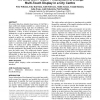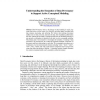12 search results - page 2 / 3 » Why and How Hippocampal Transition Cells Can Be Used in Rein... |
AAMAS
2007
Springer
13 years 11 months ago
2007
Springer
Learning Automata (LA) were recently shown to be valuable tools for designing Multi-Agent Reinforcement Learning algorithms. One of the principal contributions of LA theory is that...
ATAL
2011
Springer
12 years 5 months ago
2011
Springer
The field of multiagent decision making is extending its tools from classical game theory by embracing reinforcement learning, statistical analysis, and opponent modeling. For ex...
ICANN
2010
Springer
13 years 5 months ago
2010
Springer
Abstract. Developing superior artificial board-game players is a widelystudied area of Artificial Intelligence. Among the most challenging games is the Asian game of Go, which, des...
CHI
2008
ACM
14 years 5 months ago
2008
ACM
We present data from detailed observations of CityWall, a large multi-touch display installed in a central location in Helsinki, Finland. During eight days of installation, 1199 p...
ER
2006
Springer
13 years 9 months ago
2006
Springer
: Data Provenance refers to the lineage of data including its origin, key events that occur over the course of its lifecycle, and other details associated with data creation, proce...


